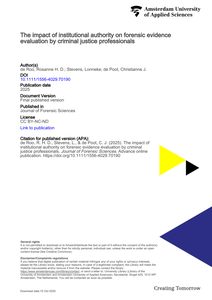Accurate and reliable decision-making in the criminal justice system depends on accurate expert reporting and on the correct interpretation of evidence by the judges, prosecutors, and defense lawyers. The present study aims to gain insight into the judiciary's capability to assess the accuracy and reliability of forensic expert reports by first examining the extent to which criminal justice professionals are able to differentiate between an accurate (or sound) expert report and an inaccurate (or unsound) expert report. In an online questionnaire, 133 participants assessed both a sound and an unsound expert report. The findings show that, on average, participants were unable to significantly distinguish between sound and unsound forensic expert reports. Second, the study explored the influence of institutional authority on the evaluation of forensic expert reports. Reports that were not recognized as flawed—particularly those originating from well-known and reputable institutions—were subjected to less critical examination, increasing the risk of evaluation errors. These results suggest that the perceived institutional authority influences the assessment of forensic evidence. The study highlights the need for tools to support criminal justice professionals in evaluating forensic evidence, particularly when experts are unregistered. Recommendations include adhering to established quality standards, consulting counter-expert evaluations, improving courtroom communication, and enhancing forensic knowledge through training. Overall, the findings underscore the importance of critical evidence evaluation to reduce the risk of misinterpretation and wrongful convictions in the judicial process.
DOCUMENT

Forensic reports use various types of conclusions, such as a categorical (CAT) conclusion or a likelihood ratio (LR). In order to correctly assess the evidence, users of forensic reports need to understand the conclusion and its evidential strength. The aim of this paper is to study the interpretation of the evidential strength of forensic conclusions by criminal justice professionals. In an online questionnaire 269 professionals assessed 768 reports on fingerprint examination and answered questions that measured self-proclaimed and actual understanding of the reports and conclusions. The reports entailed CAT, verbal LR and numerical LR conclusions with low or high evidential strength and were assessed by crime scene investigators, police detectives, public prosecutors, criminal lawyers, and judges. The results show that about a quarter of all questions measuring actual understanding of the reports were answered incorrectly. The CAT conclusion was best understood for the weak conclusions, the three strong conclusions were all assessed similarly. The weak CAT conclusion correctly emphasizes the uncertainty of any conclusion type used. However, most participants underestimated the strength of this weak CAT conclusion compared to the other weak conclusion types. Looking at the self-proclaimed understanding of all professionals, they in general overestimated their actual understanding of all conclusion types.
DOCUMENT

This article discusses, from the local professional perspective, access to justice for person-specific interventions to prevent or counter (violent) extremism in Europe. Using a Dutch case study it focusses on legal protection for hand-tailored interferences that are part of a wider-ranging counter-terrorism policy. While the so-called person-specific interventions, carried out by professionals, target designated high-risk individuals and groups, it is primarily the municipal authority that coordinates these criminal –, administrative – or social based measures. Furthermore, although researchers and human rights advocates have repeatedly sounded the alarm over access to justice for those affected, little research has been done into how those responsible for implementation perceive the necessity of legal protection. Also, the potential side-effects such as executive arbitrariness are modestly reflected in the literature. Henceforth, by reviewing policy documents and conducting semi-structured interviews, this exploratory study concludes that as far as legal protection for hand-tailored interferences are concerned, local professionals have faith in the checks and balances of the criminal justice system. Yet from their perspective this was less self-evident in cases of administrative – or social measures. Therefore, one may wonder if legal protections for person-specific interventions that deal with (potential) extremists are sufficient in practice.
MULTIFILE